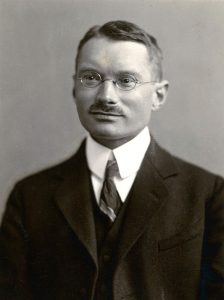
Several clay tablets from the De Liagre Böhl collection are presented on this website. Therefore, a short note on how this collection came into being is in place.
The de Liagre Böhl collection is the largest collection of clay tablets in the Netherlands. It is currently housed in the Netherlands Institute for the Near East (NINO). The collection was assembled by the late Prof. F.M.Th. de Liagre Böhl (1882-1976), an important figure who helped to shape Assyriology in the Netherlands. More than 3,000 clay tablets with cuneiform writing on them, dating from ca. 3,000 BCE to the 1st century BCE, and several other objects from the ancient Middle East, such as seals, figurines, and even an Egyptian bird mummy, make up the collection. Every object carries a collection number that starts with LB, which stands for De Liagre Böhl.
Clay tablets from the legacy of Prof. F.E. Peiser came into Böhl’s possession and formed the foundation of the collection. Other objects have been purchased by Böhl himself, either in the Middle East or from European antiques dealers. Böhl traveled to the Middle East on multiple occasions. He visited Palestine, Syria, Egypt, Turkey, Iraq, and Iran, either for study purposes, as a participant of an archaeological excavation, or as a tour guide. Photographs of his travels are available here. On these trips he often bought antiquities – primarily clay tablets with cuneiform writing on them – for his own collection. In those days it was still legal to take antiquities out of these countries. Nowadays this is strictly forbidden.
After a professorship in Hebrew and Israelite Antiquities at the University of Groningen (1912-1927), Böhl became professor of Assyriology at Leiden University in 1927. The objects in his collection that were bought with funds of the university in Groningen remained there. The rest of his collection came with him to Leiden. In 1951, a year before Böhl had to retire (unwillingly), he sold his collection to the NINO, where it remains until this day. Some objects, including clay tablets, are on display in the Rijksmuseum van Oudheden (Dutch National Museum of Antiquities) in Leiden.
Bibliography
- Böhl, F.M.Th. 1933: Mededeelingen uit de Leidsche Verzameling van Spijkerschrift-Inscripties, I: oorkonden uit de periode der rijken van Sumer en Akkad (3000-2000 v. Chr.), (Mededeelingen der koninklijke akademie van wetenschappen, afdeeling letterkunde deel 76, serie B, No. 9), Amsterdam.
- Nogarede, S.-J. 2012: Franz Marius Theodor de Liagre Böhl en de archeologie van het Nabije Oosten in Nederland, BA thesis, Leiden University.
- van Zoest, C. and S. Berntsen 2014: “75 jaar NINO: Geschiedenis van het Instituut in hoofdlijnen”, in: O.E. Kaper and J.G. Dercksen (eds.), Waar de geschiedenis begon. Nederlandse onderzoekers in de ban van spijkerschrift, hiërogliefen en aardewerk. Uitgave naar aanleiding van het 75-jarig bestaan van het Nederlands Instituut voor het Nabije Oosten, 1939-2014, Leiden, 3–29.
Author: Lidewij van de Peut
Published on 29 November 2018
